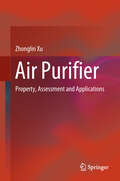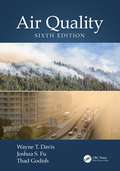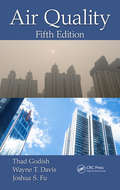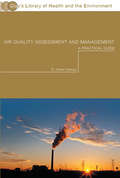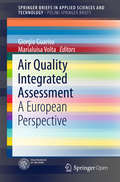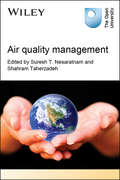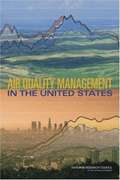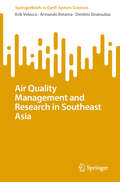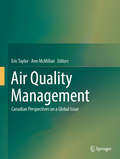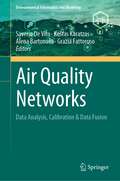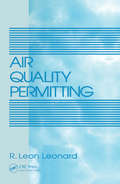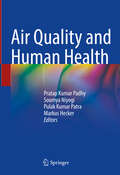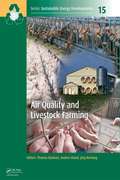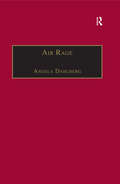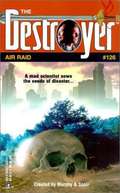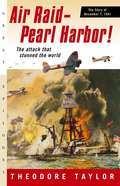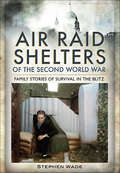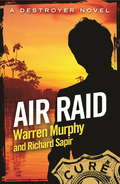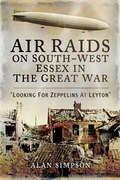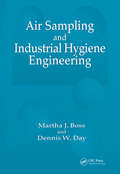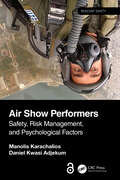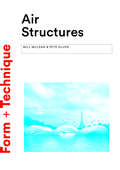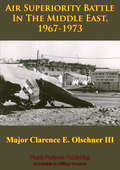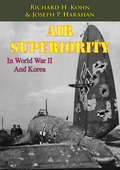- Table View
- List View
Air Purifier: Property, Assessment and Applications
by Zhonglin XuThis book discusses the development, types and application principles of portable air purifiers in China. It analyzes the theoretical characteristics of air purifiers under various operational conditions, and points out that the term “Clean Air Delivery Rate” cannot be used to precisely reflect the problems that occur under various operational conditions. By comparing theoretical and measured data, it highlights the mainfeatures of air purifiers and key points in the design process for different applications. Calculation methods for the indoor particle concentration and the self-purification time are also provided. The book describes the conditions for window opening in smog and for selecting air purifiers, and proposes a newmethod for improvingtheir measurement. In closing, it includes a new assessment index.
Air Quality
by Joshua S. Fu Wayne T. DavisThe sixth edition of a bestseller, Air Quality provides students with a comprehensive overview of air quality, the science that continues to provide a better understanding of atmospheric chemistry and its effects on public health and the environment, and the regulatory and technological management practices employed in achieving air quality goals. Maintaining the practical approach that has made previous editions popular, the chapters have been reorganized, new material has been added, less relevant material has been deleted, and new images have been added, particularly those from Earth satellites. New in the Sixth Edition New graphics, images, and an appended list of unit conversions New problems and questions Presents all-new information on the state of air quality monitoring Provides the latest updates on air quality legislation in the United States Updates the effects of air pollution and CO2 on climate change Examines the effects of the latest changes in energy production and the related emissions and pollutants Offers broadened coverage of air pollutant emissions and air quality in a global context This new edition elucidates the challenges we face in our efforts to protect and enhance the quality of the nation’s air. It also highlights the growing global awareness of air quality issues, climate change, and public health concerns in the developing world. The breadth of coverage, review questions at the end of each chapter, extensive glossary, and list of readings place the tools for understanding into your students’ hands.
Air Quality
by Thad Godish Joshua S. Fu Wayne T. DavisThe fifth edition of a bestseller, Air Quality provides students with a comprehensive overview of air quality, the science that continues to provide a better understanding of atmospheric chemistry and its effects on public health and the environment, and the regulatory and technological management practices employed in achieving air quality goals.
Air Quality Assessment and Management: A Practical Guide (Clay’s Library of Health and the Environment)
by Dr Owen HarropAir Quality Assessment and Management: A Practical Guide describes the techniques available for an assessment while detailing the concepts and methodologies involved. It reviews the principles of air quality management; primary sources of air pollution; impact of emissions on human health, flora and fauna; scoping of air quality impacts; baseline monitoring; impact prediction; impact significance; and pollution mitigation and control. Emphasis will be placed on the practical side of AQA, with numerous international case studies and exercises to aid the reader in their understanding of concepts and applications.
Air Quality Integrated Assessment: A European Perspective (SpringerBriefs in Applied Sciences and Technology)
by Giorgio Guariso Marialuisa VoltaThis book reports onthe results of an extended survey conducted across Europe within the frameworkof the APPRAISAL FP7 projectto determine the extent to which an integrated assessment approach toair quality is being adopted, on the one hand, by regional and local authorities to develop airquality plans and, on the other, by researchers. Followinga detailed analysis of the role and structure of the components of anintegrated assessment study, the results of the survey are considered from avariety of perspectives. Aboveall, the book discusses the new light the survey sheds on emissionabatement policies and measures planned at regional and local scales, and on their synergies/trade-offs with measures implementedat the national scale. Detailed consideration is given to the currently available modelingmethodologies foridentifying emissionsources, assessing theeffectiveness of emission reduction measures, and evaluating the impacts of emissionabatement measures on human health. Current strengths and weaknesses revealedby the survey are explored, and the application of an integrated assessment tool in two case studies (in Brussels and Porto) is discussed. The book will appeal to all those interested in the use of integratedassessment in connection withthe sources, effects and control of air pollution.
Air Quality Management
by Shahram Taherzadeh Suresh NesaratnamDesigned to accompany the new Open University course in Environmental Monitoring and Protection, this is one of four new titles which will equip the reader with the tools to undertake Environmental Impact Assessments (EIAs). Used in planning, decision-making and management, EIAs review both the theoretical principles and environmental considerations of engineering and environmental projects to help steer fundamental legislation in the right direction. Air Quality Management begins with an introduction to the atmosphere around us and the units of concentration. It then discusses the importance of meteorology and the part it plays in air quality, before detailing the main types of air pollutants, their sources, and their effects on humans and their environments. Further chapters discuss measurement technologies and systems, as well as a selection of control and elimination methods. Finally, the book details methods of modelling atmospheric dispersion.
Air Quality Management In The United States
by National Research Council of the National AcademiesManaging the nation's air quality is a complex undertaking, involving tens of thousands of people in regulating thousands of pollution sources. The authors identify what has worked and what has not, and they offer wide-ranging recommendations for setting future priorities, making difficult choices, and increasing innovation. This new book explores how to better integrate scientific advances and new technologies into the air quality management system. The volume reviews the three-decade history of governmental efforts toward cleaner air, discussing how air quality standards are set and results measured, the design and implementation of control strategies, regulatory processes and procedures, special issues with mobile pollution sources, and more. The book looks at efforts to spur social and behavioral changes that affect air quality, the effectiveness of market-based instruments for air quality regulation, and many other aspects of the issue. Rich in technical detail, this book will be of interestto all those engaged in air quality management: scientists, engineers, industrial managers, law makers, regulators, health officials, clean-air advocates, and concerned citizens.
Air Quality Management and Research in Southeast Asia (SpringerBriefs in Earth System Sciences)
by Erik Velasco Armando Retama Dimitris StratouliasThis book examines the capabilities for monitoring air quality, developing emission inventories, and running chemical-transport models for regulatory, forecasting, and research purposes in Southeast Asia. It also reviews scientific efforts made to better understand and characterize air pollution in the region. Poor air quality poses a threat to public health. It affects people's lives and undermines economic growth, but as in many other parts of the world, it has been overlooked in Southeast Asia. International assessments suggest that it is the culprit of 260-thousand premature deaths in the region each year, entailing a monetary cost equivalent to 6.75% of the regional GDP. Reducing air pollution requires concerted efforts from all Southeast Asian nations to implement local and regional air quality policies following a science-policy approach. For such endeavor, it is essential to develop tools that enable timely and reliable air quality management. This entails collecting data to characterize the magnitude, origin, and impact of air pollution to support corrective actions. The objective of this book is to provide a starting point for a science-based conversation about implementing solutions to Southeast Asia's air pollution problem by bringing together an analysis of the availability of air quality data and studies from across the region.
Air Quality Management: Canadian Perspectives on a Global Issue
by Ann Mcmillan Eric TaylorThis book provides a wide overview of the issues related to managing of air quality in Canada. Learn about the air issues that have caused impacts to ecosystems or human health and hence been targeted to be managed. Discover how Canada's national governance involving a federal government along with provincial and territorial governments impacts the air quality management process. Understand how Canadians manage their air quality in context with the USA, their largest and closest neighbour. Benefit from the experience of 43 of Canada's most experienced air quality management professionals who share their insights into the state of air quality in Canada today, how it is managed, as well as giving a glimpse into the future.
Air Quality Networks: Data Analysis, Calibration & Data Fusion (Environmental Informatics and Modeling)
by Kostas Karatzas Saverio De Vito Alena Bartonova Grazia FattorusoThis volume offers expert contributions proposing new and recently set scientific standards for smart air quality (AQ) networks data processing, along with results obtained during field deployments of pervasive and mobile systems. The book is divided into 5 main sections; 1) future air quality networks, 2) general data processing techniques, 3) field deployments performances, 4) special applications, and 5) cooperative and regulatory efforts. The authors offer different sources of data for the production of trustworthy insights, including spatio-temporal predictive AQ maps meant to boost citizen awareness, and informed participation in remediation and prevention policies. Readers will learn about the best and most up-to-date practices for measuring and assessing air quality, while also learning about current regulatory statuses regarding air quality technology design and implementation. The book will be of interest to air quality regulatory agencies, citizen science groups, city authorities, and researchers and students working with air quality sensors and geostatistics.
Air Quality Permitting
by R. Leon LeonardThis practical book covers all of the fundamentals for obtaining air quality permits for new sources of air pollutant emissions and Title V operating permits for operating sources. Written for facility environmental managers, consultants, and air quality regulatory staff, Air Quality Permitting provides a thorough discussion on the strategies of successfully permitting a facility.
Air Quality and Human Health
by Markus Hecker Pratap Kumar Padhy Soumya Niyogi Pulak Kumar PatraThe book is one of the outcomes of the SPARC (Scheme for Promotion of Academic and Research Collaboration) project titled "Fine particulates matters in the air environment and their cancer risks in human beings," sponsored by MHRD (now MoE), Govt. of India. The editors of the book are PIs and Co-PIs of the said project. The text deliberates on air pollution's health risks with contributions from well-known experts from diverse research fields (environmental science, toxicology, geology, public health science, biology, physics, chemistry, and geospatial technology). It explores it its control and mitigation strategies. The book provides an up-to-date overview of the modern methods and tools used in air quality monitoring and human health risk assessment. Case studies from different global settings offer invaluable insights into air pollution-related regional health issues. It addresses all aspects of air quality, covering indoor-outdoor air pollution, gaseous and particulate pollutants; characterization of source and pathways of air pollutants; and the modeling and assessing of health risks (respiratory, epidemiological, and toxicological) with regional and global perspectives. It also addresses air quality management issues. The lucid explanation of the role of oxidative stress mechanisms and molecular biomarkers (genomics, proteomics) may be considered as inputs into the development of cancer therapeutics. Along with providing a scientific basis for air pollution, this book will help readers appreciate the environmental determinants of public health and apply research evidence to improve the quality of life. It also delineates future research initiatives and policy actions needed to protect human health from air pollution, locally and globally. The book will be of great educational value and help for consultation and teaching.
Air Quality and Livestock Farming (Sustainable Energy Developments)
by Thomas Banhazi Andres Aland Jörg HartungAir quality has a direct influence on health, welfare and production performance of livestock as the high concentrations of noxious gases, dust and airborne microorganisms are likely to reduce production efficiency and the general welfare of farm animals. Long term exposure to particulates in livestock buildings might also affect the respiratory health of farm workers. Dust in animal buildings contains many biologically active substances such as bacteria, fungi, endotoxins and residues of antibiotics (as a result of veterinary treatments) that are suspected to be hazardous to human health. Furthermore, air pollutants emitted from livestock buildings can reduce air, water and soil quality and can potentially undermine the health of nearby residents. Airborne emissions include ammonia, methane, nitrous oxide, particulates like dust and microorganisms. In addition, other potentially harmful substances such as heavy metals, antibiotic residues and components of disinfectants might be also emitted from livestock building that are potentially damaging to ecosystems. In this book, key aspects of agricultural air quality, such as monitoring, managing and reducing airborne pollutants in and around livestock facilities are reviewed. Features: addressing the raising awareness of the importance of optimal health and welfare for lifestock species with contributions from international specialists and researchers providing up-to-date information for professionals involved in modern animal producti This book will be useful for farming professionals, academics, students, policy makers, business leaders, regulatory bodies and agricultural consultants.
Air Rage: The Underestimated Safety Risk
by Angela DahlbergThis book introduces a new Human Factors concept that includes the air passenger as an integral part of the aviation system. It develops a revised Reason Model on Human Error that applies its principles to the prevention of passenger misconduct, with a focus on organizational issues affecting the interface between the air passenger and the airlines. It also builds a synergistic model addressing the traditional conflict between safety and service objectives. Incorporating a diffusion of air traveller tension, a Passenger Risk Management Model leads to a strategic approach for reducing incidents of Air Rage.
Air Raid (Destroyer, #126)
by Warren MurphyDON'T BREATHE THE AIR They are tiny, genetically engineered blue seeds that mature quickly into trees that literally suck all the oxygen out of the air. They're the earth-friendly but highly secretive Congress of Concerned Scientists, and now they've been snatched by its head, Dr. Hubert St. Clair. Having killed off all but one of his scientific team, he's leading Remo and Chiun on a chase through the proverbial forest. He's got enough seeds to choke off the world's oxygen supply, and the ability to create environmental disasters at will. Battling everything from acid rain to blistering heat to frigid cold, the Destroyer races to thwart double disaster in the Amazon rainforest: St. Clair is planting seeds like a maniac and a U.S. President prepares to nuke Brazil into oblivion.
Air Raid -- Pearl Harbor!: The Story of December 7, 1941
by Theodore TaylorIt examines from both the American and Japanese points of view the political and military events leading up to the attack on Pearl Harbor.
Air Raid Shelters of the Second World War: Family Stories of Survival in the Blitz
by Stephen WadeThis book features the design, creation and use of air raid shelters, including interviews with people who used them during the Second World War. The different types of bunkers/air raid shelters (both public and in peoples gardens) are covered and the strength and weakness of their designs discussed, using original designs and primary material. The nostalgia/social history of the book covers peoples experiences of staying in the air raid shelters. These are divided into topics, including getting to the shelters (how they reacted to the sirens or whether they just moved into the shelters, especially those in gardens, long-term), facilities, health issues, morale and safety, both real and perceived. In recent years, air raid shelters have been converted into different uses, including homes, and the book will finish with a brief chapter concerning the future and preservation of these once vital buildings.
Air Raid: Number 126 in Series (The Destroyer #126)
by Warren Murphy Richard SapirDon't breathe the air...They are tiny, genetically engineered blue seeds that mature quickly into trees that literally suck all the oxygen out of the air. They're the twisted experiment of the earth-friendly but highly secretive Congress of Concerned Scientists, and now they've been snatched by its head, Dr. Hubert St. Clair.Having killed off all but one of his scientific team, he's leading Remo and Chiun on a chase through the proverbial forest. He's got enough seeds to choke off the world's oxygen supply, and the ability to create environmental disasters at will. Battling everything from acid rain to blistering heat to frigid cold, the Destroyer races to thwart double disaster in the Amazon rainforest: St. Clair is planting seeds like a maniac and a U.S. President prepares to nuke Brazil into oblivion.Breathlessly action-packed and boasting a winning combination of thrills, humour and mysticism, the Destroyer is one of the bestselling series of all time.
Air Raids on South-West Essex in the Great War: Looking for Zeppelins at Leyton
by Alan SimpsonA quarter of a century before the Blitz of 1940, the inhabitants of south-west Essex were terrorized by an earlier aerial menace. Over the course of four years, German Zeppelins, Gothas and Giants flew above their homes, unleashing hundreds of highly explosive and incendiary bombs on London. During three of these raids, bombs were dropped on Leyton and many others landed elsewhere in south-west Essex. These early air raids are now largely forgotten in local memory, but for the inhabitants of the time the attacks were unprecedented, unexpected and lethal.In the years since the Great War a great deal of literature has been published on London's first air raids and about the defence network that evolved around the metropolis, but what happened in the capital's eastern suburbs and the nearby Essex countryside has received less coverage. This meticulously researched and insightful book attempts to put that right, looking at the area which, in 1914, was part of south-west Essex, but now comprises the London boroughs of Waltham Forest, Redbridge, Havering, Newham, and Barking and Dagenham.Focussing in particular on Leyton and Ilford, this is the first book to ever examine what happened before and after the raiders reached and bombarded the capital. The author has included a wide range of contemporary letters, diaries and newspaper reports from local sources, plus several previously unseen photographs. To set the story in its wider context, the book also contains a wealth of information about the defence of the London area generally and vivid reports from combatants on both sides.
Air Sampling and Industrial Hygiene Engineering
by Martha J. Boss Dennis W. DayWe know certain chemicals cause problems in the workplace. The issues now are: Where do they occur in the workplace? How can we best evaluate them? What are the procedures for dealing with them safely? Many books simply define the problem and tell you that you need a program. Air Sampling and Industrial Hygiene gives you a guide to air sampling protocols from start to finish. The book presents sampling technology updated with today's tools - such as microcircuitry and remote sensing. The authors emphasize an interdisciplinary approach to understanding how air monitoring can adequately report current environmental conditions associated with outdoor media, indoor remediation efforts, proximal equipment, interior line monitoring, and the interrelationship of ventilation parameters. In addition to providing the how-tos of sampling, this guide covers the basics of chemical risk assessment, biological assessment, engineering evaluation of mechanical system design criteria, and chemical or process engineering hazard assessments. It presents the information using text, text outlines, graphics, and pictures - including cross sections of instrumentation and side bars to elaborate on complex concepts.Faulty readings caused by poor sampling techniques can be very costly. This book provides the how-tos for making design engineering and on-site decisions as to instrumentation selection and scheduled usage. Air Sampling and Industrial Hygiene Engineering will allow you to complete the sampling process systematically and correctly from initial suspicions to the use of obtained results.
Air Show Performers: Safety, Risk Management and Psychological Factors (Resilient Safety)
by Manolis Karachalios Daniel Kwasi AdjekumAir shows are high-risk activities that must be conducted with careful thought towards the general public, spectators, and flying and nonflying participants to ensure that the activity is as safe as reasonably possible. The impromptu, ad hoc, unrehearsed or unplanned must never be attempted. This book offers a holistic overview of the state of safety, including safety cultural variables, safety risk parameters, and human performance factors, in the international air show community. This book aims to close the knowledge gap on safety management in air shows. It imparts to the aviation sector and other high-risk and high-performance industries the experience and knowledge that airshow performers have gained regarding risk assessment, psychological aspects, and mindfulness techniques used for safe and effective performances. The book highlights how resilient safety culture can change the air show community's mentality to deliver safer and more spectacular air show events and promotes the culture of excellence that the air show community is wedded to. The reader will obtain a thorough understanding of safety issues in air shows. Air Show Performers: Safety, Risk Management, and Psychological Factors is a critical read for professionals within the international air show community including nonflying participants. Its appeal extends to practitioners in aviation, health and safety and events management.“[…] For sure, this book will become a reference and a source of inspiration for future generations of Display Pilots.”Jacques Bothelin, French Aerobatic Jet Team Leader, Honorary Board Member European Airshow CouncilManolis Karachalios was the Hellenic Air Force’s F-16 Demo Team “ZEUS” Display Pilot for the 2010–2012 display seasons. Dr. Karachalios holds a Master of Business Administration (MBA) in Aviation Management from Coventry University, and a Doctor of Philosophy (PhD) in Aerospace Sciences from the University of North Dakota focusing on air show safety and development.Daniel Kwasi Adjekum has over 25 years of experience in aviation as a former Ghana Air Force squadron commander, command pilot, and air display safety director. He was also an airline pilot and is currently an aviation safety consultant and professor of aviation. He is an Internationally recognized aviation safety subject-matter expert and an International Air Transport Association (IATA) certified Safety Management Systems (SMS) implementation and control expert.
Air Structures
by William McLeanAir can be used in a variety of ways to make lightweight, flexible structures. It can be used to make inflatable structures, mobile structures, and temporary buildings, it can also activate movable elements and act as a means of constructing buildings that would be impossible with conventional construction methods.This book looks at every facet of the subject, examining the different types of air structure: super pressure buildings, air beam structures, buoyant structures, inflatable structures, and many more. It also looks at the construction methods that use air, such as air-inflated steel, aerated concrete and blow moulding. Filled with photographs, models, drawings, and diagrams, this is the ideal book for curious students, designers and architects.
Air Structures (Form + Technique)
by Peter Silver William McLean Pete SilverAir can be used in a variety of ways to make lightweight, flexible structures. It can be used to make inflatable structures, mobile structures, and temporary buildings, it can also activate movable elements and act as a means of constructing buildings that would be impossible with conventional construction methods.This book looks at every facet of the subject, examining the different types of air structure: super pressure buildings, air beam structures, buoyant structures, inflatable structures, and many more. It also looks at the construction methods that use air, such as air-inflated steel, aerated concrete and blow moulding. Filled with photographs, models, drawings, and diagrams, this is the ideal book for curious students, designers and architects.
Air Superiority Battle In The Middle East, 1967-1973
by Major Clarence E. Olschner IIIThis paper is an historical study of the strategy, tactics, and weapons employed by Israel, Egypt, and Syria in the battle for air superiority from 1967 through 1973. The study is developed chronologically beginning with the 1967 War, through the War of Attrition, and ending with the cease-fire in the 1973 War. It has been compiled from an extensive review of unclassified, primarily secondary, unofficial sources. The paper concludes that, in a mid-intensity war with modern air forces and air defense forces: 1) The achievement of strategic, tactical, and/or technological surprise can significantly influence the battle for air superiority, 2) Missiles have demonstrated the capability to significantly influence the air superiority battle in surface-to-air, air-to-air, and air-to-ground operations, 3) Air superiority can be achieved over the modern battlefield only by defeating both surface-to-air and air-to-air capabilities of the enemy, 4) The achievement of air superiority over the battle area requires the combined efforts of air and land forces of which long range artillery may be the most effective weapon for the suppression of surface-based air defenses.
Air Superiority In World War II And Korea [Illustrated Edition]
by Joseph P. Harahan Richard H. KohnIncludes over 20 illustrations.In November 1981, Lt. Gen. Hans H. Driessnack, Assistant Vice Chief of Staff, asked the Historical Program to assemble a small number of retired officers for a group oral history interview. General Driessnack believed that in reminiscing together, these officers would recall incidents and experiences that might otherwise go unrecorded; by exchanging ideas and questioning each other--in effect, interviewing each other--they would recall material that would be of interest and importance to the Air Force today. General Driessnack also suggested selecting retired officers from the senior statesman conference, a gathering every spring at which retired four-star generals are briefed on Air Force issues and then discuss them with contemporary Air Force leaders.The result is the following interview. The four participants--Gen. James Ferguson, Gen. Robert M. Lee, Gen. William W. Momyer, and Lt. Gen. Elwood R. "Pete" Quesada--gathered on May 21, 1982, around a table in the Vandenberg room at the Bolling Air Force Base Officers' Club. For approximately two and one half hours they responded to questions sent to them earlier and discussed air superiority in World War II and Korea. Their discussions ranged far and wide: flying in the pre-World War II Army Air Corps, campaigning in North Africa and Western Europe in World War II, planning and participating in the Normandy invasion, using secret intelligence supplied by Ultra, struggling to codify tactical air doctrine in the post-war years, fighting the air battle in Korea, and thinking about the general problem of air superiority throughout their careers. This collective interview is not history but the source material on which history rests; it is a memoir, a first-hand account by air leaders who flew, fought, and commanded tactical air forces in combat.
